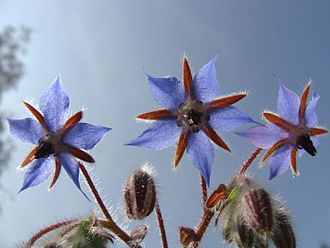Borage

Borage (/ˈbʌrɪdʒ/ (About this soundlisten)[1] or /ˈbɒrɪdʒ/;[2] Borago officinalis), also known as a starflower, is an annual herb in the flowering plant family Boraginaceae. It is native to the Mediterranean region, and has naturalized in many other locales.[3] It grows satisfactorily in gardens in most of Europe, such as Denmark, France, Germany, and the United Kingdom, remaining in the garden from year to year by self-seeding. The leaves are edible and the plant is grown in gardens for that purpose in some parts of Europe.The plant is also commercially cultivated for borage seed oil extracted from its seeds. The plant contains pyrrolizidine alkaloids, some of which are hepatotoxic, mutagenic, and carcinogenic (see below under Phytochemistry).
B. officinalis grows to a height of 60–100 cm (2 ft 0 in–3 ft 3 in), and is bristly or hairy all over the stems and leaves; the leaves are alternate, simple, and 5–15 cm (2–6 in) long. The flowers are complete, perfect with five narrow, triangular-pointed petals. Flowers are most often blue, although pink flowers are sometimes observed. White-flowered types are also cultivated. The blue flower is genetically dominant over the white flower.[4] The flowers arise along scorpioid cymes to form large floral displays with multiple flowers blooming simultaneously, suggesting that borage has a high degree of geitonogamy (intraplant pollination).[4] It has an indeterminate growth habit, which may lead to prolific spreading. In temperate climates such as in the UK, its flowering season is relatively long, from June to September. In milder climates, borage blooms continuously for most of the year.
Traditionally, borage was cultivated for culinary and medicinal uses, although today, commercial cultivation is mainly as an oilseed. Borage is used as either a fresh vegetable or a dried herb. As a fresh vegetable, borage, with a cucumber-like taste, is often used in salads or as a garnish.[5] The flower has a sweet, honey-like taste and is often used to decorate desserts and cocktails,[5] most commonly, frozen in ice cubes.[6]
